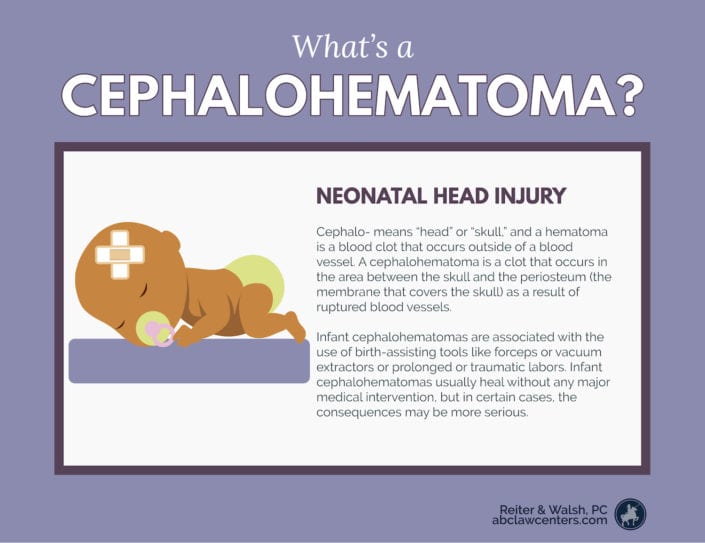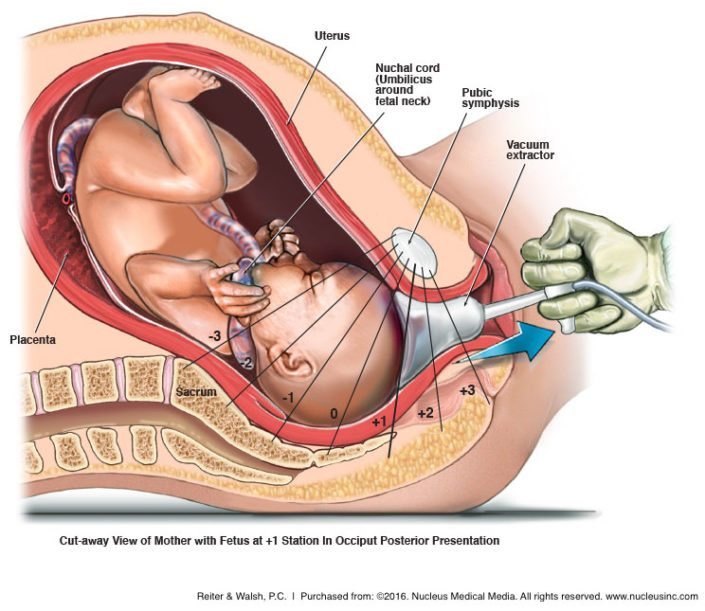What is a cephalohematoma?
What you need to know about the lump on your baby’s head
The moment you notice something unusual on your infant’s head, your heart may skip a beat. As parents, it’s natural to be concerned and to have questions when faced with something unfamiliar, especially when it involves your newborn. A cephalohematoma, the lump that may appear on your baby’s head, can be particularly worrying, but it’s important to know that you are not alone in this journey.
A cephalohematoma is a blood clot that occurs between the skull and the scalp as a result of ruptured blood vessels. Cephalo- means “head” or “skull,” and hematoma describes internal bleeding, usually clotted.
Newborn cephalohematomas can be caused by prolonged labor, or a difficult vaginal birth. Cephalohematomas usually happen at the same time as other types of birth trauma such as caput succedaneum (head swelling), and are often associated with the use of birth-assisting tools such as forceps or vacuum extractors. Newborn cephalohematomas usually heal without any major medical intervention, but if improperly treated, the consequences can be serious. If you’re feeling overwhelmed or unsure about your baby’s health, please remember that you don’t have to navigate this on your own.
If you suspect a birth injury caused the cephalohematoma, an experienced birth injury attorney can help you understand your options, ensuring that your child receives the care they need and that your family is supported during this challenging time.

Identifying newborn cephalohematomas
An infant cephalohematoma usually looks like a raised bump on a baby’s head. The bump typically appears several hours to a day after birth and is often largest on the second or third day. By that time, the internal bleeding typically stops. The cephalohematoma may initially be soft, but get firmer over time.
Often, appearance alone is enough to diagnose a cephalohematoma. However, doctors may order an X-ray, CT scan, MRI scan, or ultrasound to verify.
Are Newborn Cephalohematomas Common?
According to the Cleveland Clinic, cephalohematomas are present in 2.5% of difficult and prolonged vaginal deliveries. When comparing cephalohematomas to other birth injuries, while they are not the most frequent, they are still one of the more commonly observed complications, especially in births involving the use of birth-assisting tools like forceps or vacuum extractors where a baby may suffer head trauma.
Advances in technology and more refined delivery techniques have helped to minimize these risks, though they have not been eliminated entirely. This progress means that while cephalohematomas remain a concern, the overall trend is toward safer deliveries and better outcomes for both mother and child.
What are newborn cephalohematoma risk factors?
Any type of trauma to the baby’s head can potentially cause a cephalohematoma. More specific examples include the following:
- Prolonged or difficult delivery
- Cephalopelvic disproportion (CPD) describes a situation where the baby’s head is larger than the mother’s pelvic opening. This can prolong delivery and/or make it difficult for the baby’s head to safely leave the mother’s pelvis.
- Fetal macrosomia occurs when the baby is larger than is expected for gestational age. This may also increase the risk of trauma to the baby’s head during delivery.
- Abnormal fetal position
- Birth of multiples (twins, triplets, or more)
- Use of forceps or vacuum extractors: These assistive delivery tools can increase the risk of cephalohematomas and many other problems, including skull fractures and permanent brain injury. They must be used only by very experienced medical professionals, and only under a strict set of circumstances.
Understanding these risk factors for newborn cephalohematoma can help you and your healthcare provider take steps to minimize the likelihood of a cephalohematoma during delivery. However, even with precautions, birth injuries can still occur, and it’s important to talk to a doctor if you have concerns about your newborn’s health.

Does a Cephalohematoma Pose a Risk to a Baby’s Brain?
A cephalohematoma itself typically does not pose a direct risk to a baby’s brain, as it occurs between the skull and the scalp, outside the cranial cavity where the brain is located. However, there are some potential complications associated with cephalohematomas that could indirectly impact the baby’s health and development:
- Anemia: In some cases, a large cephalohematoma can cause significant blood loss, leading to anemia. This condition occurs when there aren’t enough red blood cells to carry oxygen throughout the body, which can affect overall health.
- Jaundice: As the body reabsorbs the blood from the cephalohematoma, the breakdown of red blood cells can lead to an increased level of bilirubin, potentially causing jaundice. While mild jaundice is common and often resolves on its own, severe jaundice can be dangerous and, if left untreated, may lead to a condition called kernicterus, which can cause brain damage.
- Infection: Although rare, if a cephalohematoma becomes infected, it could lead to more serious health concerns, including sepsis, which can affect the brain and other vital organs.
- Skull Fractures: In some instances, a cephalohematoma may be associated with an underlying skull fracture. While the fracture itself might not directly harm the brain, it increases the risk of other complications, such as an intracranial hemorrhage, which can affect the brain.
While most cephalohematomas resolve without major complications, it’s important to monitor your baby closely and consult with your healthcare provider if you notice any signs of concern, such as excessive swelling, jaundice, or unusual behavior.
If you’re worried about potential long-term effects or complications from a newborn cephalohematoma diagnosis, discussing your concerns with an experienced birth injury attorney might help you explore options for ensuring your baby’s health and well-being.
Did your baby have complications from a cephalohematoma?
Our team is here to discuss your legal options.
Early Diagnosis and Treatment
In most instances, cephalohematomas go away on their own without any major medical intervention. However, babies with cephalohematomas should be carefully monitored. Sometimes, a doctor may attempt to drain or aspirate the blood, but this is generally not advised because it increases the risk of infection and abscess.
However, if a cephalohematoma becomes infected or abscessed, draining it (along with antibiotic treatment) may then be necessary. Doctors must manage cephalohematoma infections very carefully, as they can lead to meningitis (infection of the brain).
Although cephalohematomas are generally not a major threat, they can increase the risk of health complications such as anemia and jaundice.
If a baby develops anemia, they may require a blood transfusion. Like cephalohematomas, jaundice may only be a mild issue, and it is easily treatable . However, babies with jaundice should be closely monitored. If jaundice becomes severe and doctors fail to provide appropriate treatment, it can result in cerebral palsy (CP), hearing loss, and other permanent disabilities.
Legal Help for Birth Injuries due to Medical Negligence
Complications from a cephalohematoma are preventable. If a doctor or hospital mismanages a baby’s cephalohematoma and it leads to permanent injury, that is considered medical malpractice. As a parent, it can be frustrating to learn that the people you trusted with your baby’s care made a mistake, but you do have legal options.
When choosing a firm, it’s critical that parents and caregivers trust in a team that is experienced in complex birth injury law and committed to giving their clients the best results possible. Birth injury cases can take years to complete. Our firm exclusively handles birth trauma cases to give each client the attention their case deserves.
For over 25 years, we have worked with parents like you to create a more secure future for children with birth injuries. We know it can be intimidating to speak to a lawyer about your child’s birth or even consider filing a lawsuit. That’s why our team provides free and compassionate consultations to discuss your potential case and answer any questions you may have – without any obligation to pursue a case.

We understand how difficult it can be to find free time as a parent, let alone a parent caring for an injured child. Our team is here to patiently listen at a time convenient for you – absolutely free. In fact, our clients pay nothing unless we recover a favorable settlement or verdict for their family.
Call ABC Law Centers at 248-593-5100, or contact us online. We care about your child’s birth injury and will work to secure compensation to ease your worries about their proper treatment.
Sources
1. Perry, S. E., Hockenberry, M. J., Lowdermilk, D. L., & Wilson, D. (2013). Maternal child nursing care. Elsevier Health Sciences.
2. Healthline: Cephalohematoma: Causes, Outlook, and More
3. Neonatal Jaundice Treatment & Management: Approach Considerations, Medical Care, Diet. (2018, July 25). Retrieved September 13, 2023, from https://emedicine.medscape.com/article/974786-treatment#d6
4. Shorofsky, M. J., & Bhatia, D. (2018). Newborn with spontaneous rupture of an infected cephalohematoma. International Journal of Contemporary Pediatrics, 5(2), 649-650.
5. Cleveland Clinic: Cephalohematoma